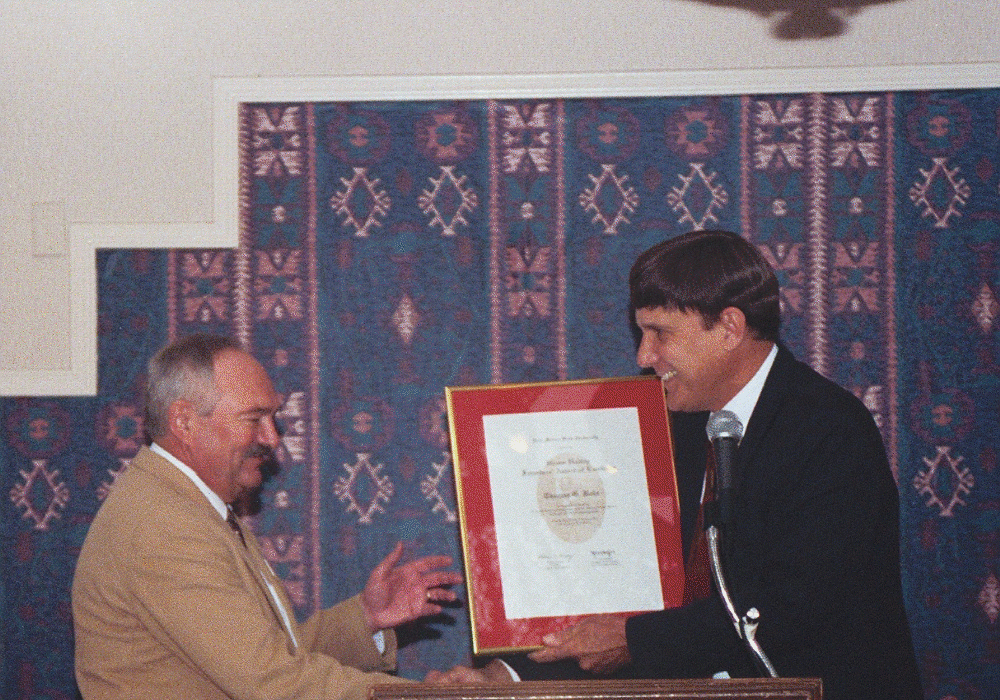“In recognition of leadership in the protection and development of water resources for New Mexico in the spirit of NMSU’s founding leader,” New Mexico State University’s executive vice president, John Owens, presented the Hiram Hadley Founders’ Award of Excellence to Thomas G. Bahr.

Only the second person to receive this prestigious award – former NMSU president Gerald Thomas was presented with the award recently – Bahr announced at this year’s WRRI Annual New Mexico Water Conference that he will retire as director of the institute next summer.
Tom has led the New Mexico WRRI since March 1978. Among other duties, he is responsible for coordinating and administering water resources research at all institutions of higher education in New Mexico.
Over the past twenty years, Tom has played a pivotal role in overseeing the evolution of water resources research and administration in our state. As WRRI director, Tom has expedited many notable research projects funded through the institute. These include topics on irrigation efficiency, recharge in the Roswell Artesian Basin and other basins, salinity and temperature effects on plants, water treatment for public supply, economic studies on water-use efficiency, a major Ogallala Aquifer study, toxicity of volatile organic compounds, management and policy research on unappropriated groundwater, removal of contaminants from drinking water, runoff and erosion processes, fishery management in New Mexico reservoirs, water-use transfers, groundwater flow and recharge modeling, transport of organics in groundwater, rainfall effects, improved plant water-use efficiency, optimizing river management, Pueblo Indian water rights, ephemeral stream infiltration and recharge, flow between streams and aquifers, toxic pollutants in surface and groundwater, removal of heavy metal ions from wastewater, and many others.
Involved from the beginning of what became known as the El Paso Water Suit, Tom, in 1982, only two years into the legal process, was quoted in the institute’s newsletter as saying, “When you look at all the resources – brilliant minds and money – tied up in this two-year legal battle, you can’t help but wonder if we all would be better off if both sides had used this talent and money to find more efficient ways to use the existing water resources of both sides.” His prescient comment continues to hold relevance today.
Tom was appointed as the Assistant to the University Attorney to assist in preparation for legal hearings to be held on the University’s protest of groundwater applications by the City of El Paso in 1985. Currently, he is co-chairman of the New Mexico/Texas Water Commission, a group representing nearly every entity with policy or management authority over water resources in the Lower Rio Grande, and charged with maximizing the utilization of Rio Grande Project waters to meet everyone’s long-term water needs.
In addition to his work at the WRRI, Tom has also accepted related appointments during the past two decades.
In 1982, he accepted a one-year appointment by the Secretary of the Interior as Director of the Office of Water Policy in Washington, D.C. There he served as the lead departmental official for analysis and coordination of the nation’s water policy.
In 1986, Tom took another leave to accept a cabinet post in the Carruthers administration as Secretary of the New Mexico Energy, Minerals and Natural Resources Department. There he was responsible for the state Park and Recreation Division, Game and Fish Department, Oil Conservation Division, Mining and Minerals Division, and Energy Conservation Division. He also served as water policy advisor to the Governor on issues of wilderness water rights, instream flow legislation, wild and scenic rivers and public lands issues.
In 1989, he was appointed by the U.S. Secretary of Energy to a five-member Blue Ribbon Panel to advise the U.S. Department of Energy on its Defense Nuclear Weapons Waste Management Program. An important aspect of this project was policy development related to potential groundwater contamination.
Other state assignments include membership on the New Mexico Water Quality Control Commission and chair of the Governor’s Technical Excellence Committee on Water Resources Task Force.
On the broader level, Tom is a member of several national and international water associations and committees, and has published extensively in the area of water quality management. He is past president of the National Institutes for Water Resources, a network of 54 Water Resources Research Institutes representing each of the 50 states, the District of Columbia, Puerto Rico, the Virgin Islands, and Guam.
Tom came to New Mexico from the Michigan Institute of Water Research, which he directed. Tom earned a B.S. in forestry from the University of Idaho, and then an M.S. and Ph.D. from Michigan State University, specializing in water chemistry and biological/physiological aspects of water quality management.
Promising to remain at the helm of the WRRI until a new director is appointed next summer, Tom plans to stay active in the water business through consulting and tending to his vineyard.
As the NMSU Founders’ Award of Excellence attested, Tom Bahr has distinguished himself with his outstanding service to the state of New Mexico through his dedication to preserving our precious water resources.
